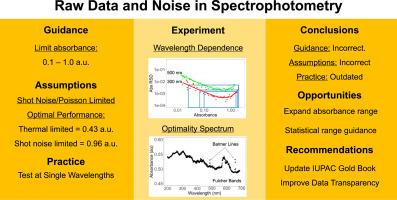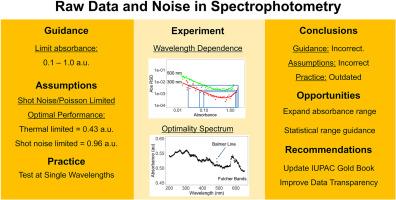Raw data and noise in spectrophotometry
IF 6
2区 化学
Q1 CHEMISTRY, ANALYTICAL
引用次数: 0
Abstract
Background
Spectrophotometers are ubiquitous in chemical and biological science; however, their precision limits are under-appreciated. Rules-of-thumb and IUPAC referenced guidance restricting absorbance ranges to minimize uncertainty are based on historically important instruments which are no longer as widely used. Advances over the last half-century changed most “raw” data from absorbance and transmittance values directly produced in analog electronics to digitized intensities. The latter are rarely provided in favour of digitally transformed derived data. Assessment of spectrophotometer limitations using digitized intensities would be straightforward with mean-variance analysis. However, in their absence, derived data evaluated at scale allows efficient characterisation of modern spectrophotometers.
Results
This study analyses signals when I and I0 are not available and only absorbance or transmittance are obtained. Current IUPAC referenced guidance indicates that absorbance should be limited between 0.1 and 1.0 a.u. with optimal performance (minimum relative standard deviation (RSD)) at 0.43 a.u. or 0.86 a.u. depending on the type of limiting noise. We characterised noise in UV–Vis spectrophotometers using three methods and report optimality spectra for the first time. We found the instruments were not Poisson optimal and best RSDs were sometimes above 1.0 a.u. We could find no evidence justifying guidance restricting absorbance to between 0.1 and 1.0 a.u. Measured RSD and light intensity are more important than absorbance values for assuring good quality measurements. However, estimating light intensity is a difficult inverse problem when I and I0 are not available, and the tested commercial instruments did not provide these.
Significance
Based on this work, classical theories are insufficient to describe spectrophotometers accurately. Furthermore, we urge IUPAC to modernise the references in its Gold Book and press instrument makers to improve data transparency. These steps are crucial to use spectrophotometers optimally.


分光光度法中的原始数据和噪声
背景分光光度计在化学和生物科学中无处不在,但其精度极限却未得到足够重视。为尽量减少不确定性而限制吸光度范围的经验法则和国际理论和应用化学联合会(IUPAC)参考指南都是基于历史上重要的仪器,而这些仪器现在已不再广泛使用。过去半个世纪的进步使大多数 "原始 "数据从模拟电子设备直接产生的吸光度和透射率值转变为数字化的强度。后者很少提供,而是提供经数字转换的衍生数据。使用数字化强度评估分光光度计的局限性可以通过均值方差分析来实现。不过,在没有这些数据的情况下,按比例评估得出的数据可以有效地确定现代分光光度计的特性。(100)结果本研究分析了无法获得 I 和 I0 而只能获得吸光度或透射率时的信号。当前的 IUPAC 参考指南指出,吸光度应限制在 0.1 至 1.0 a.u.之间,最佳性能(最小相对标准偏差 (RSD))为 0.43 a.u. 或 0.86 a.u.,具体取决于限制噪声的类型。我们使用三种方法描述了紫外可见分光光度计的噪声特性,并首次报告了最佳光谱。我们发现仪器并非泊松最优,最佳 RSD 有时高于 1.0 a.u。我们找不到任何证据证明将吸光度限制在 0.1 至 1.0 a.u 之间的指导意见是合理的。然而,在没有 I 和 I0 的情况下,估计光强是一个困难的逆问题,而测试的商用仪器并不提供这些数据。(143)意义基于这项工作,经典理论不足以准确描述分光光度计。此外,我们敦促国际理论化学和应用化学联合会更新其《金皮书》中的参考文献,并敦促仪器制造商提高数据透明度。这些步骤对于优化分光光度计的使用至关重要。(40)
本文章由计算机程序翻译,如有差异,请以英文原文为准。
求助全文
约1分钟内获得全文
求助全文
来源期刊

Analytica Chimica Acta
化学-分析化学
CiteScore
10.40
自引率
6.50%
发文量
1081
审稿时长
38 days
期刊介绍:
Analytica Chimica Acta has an open access mirror journal Analytica Chimica Acta: X, sharing the same aims and scope, editorial team, submission system and rigorous peer review.
Analytica Chimica Acta provides a forum for the rapid publication of original research, and critical, comprehensive reviews dealing with all aspects of fundamental and applied modern analytical chemistry. The journal welcomes the submission of research papers which report studies concerning the development of new and significant analytical methodologies. In determining the suitability of submitted articles for publication, particular scrutiny will be placed on the degree of novelty and impact of the research and the extent to which it adds to the existing body of knowledge in analytical chemistry.
 求助内容:
求助内容: 应助结果提醒方式:
应助结果提醒方式:


